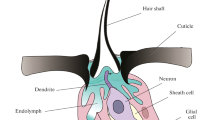Abstract.
Transient receptor potential (TRP) ion channels have been identified as cellular sensors responding to diverse external and internal stimuli. This review will cover the TRPV subfamily that comprises vertebrate and invertebrate members. The six mammalian TRPV channels were demonstrated to function in thermosensation, mechanosensation, osmosensation and Ca2+ uptake. Invertebrate TRPV channels, five in Caenorhabditis elegans and two in Drosophila, have been shown to play a role in mechanosensation, such as hearing and proprioception in Drosophila and nose touch in C. elegans, and in the response to osmotic and chemical stimuli in C. elegans. We will focus here on the role that TRPV ion channels play in mechanosensation and a related sensory (sub-)modality, osmosensation.
Similar content being viewed by others
Author information
Authors and Affiliations
Corresponding author
Additional information
Received 2 May 2005; received after revision 30 July 2005; accepted 30 August 2005
Rights and permissions
About this article
Cite this article
Liedtke, W., Kim, C. Functionality of the TRPV subfamily of TRP ion channels: add mechano-TRP and osmo-TRP to the lexicon!. Cell. Mol. Life Sci. 62, 2985–3001 (2005). https://doi.org/10.1007/s00018-005-5181-5
Published:
Issue Date:
DOI: https://doi.org/10.1007/s00018-005-5181-5




